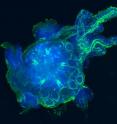Purple sea urchin metamorphosis controlled by histamine
Now that hay fever season has started, sufferers are well aware of the effect of histamines. However it is easy to forget that histamine is also a neurotransmitter involved in controlling memories, regulating sleep, and controlling secretion of gastric acid. New research published in BioMed Central's open access journal BMC Developmental Biology shows that for the purple sea urchin (Strongylocentrotus purpuratus) histamine is also responsible for controlling metamorphosis from a free swimming larval form to the spiny adult living on the sea floor. Echinoids (sea urchins and sand dollars) have evolved a range of reproductive and developmental strategies. One of them involves a free swimming (pelagic) larval form which after a period of 'competence', while the animal searches for an appropriate settlement site, metamorphoses into the adult form (benthic) which lives on the sea floor. In the purple sea urchin metamorphic changes occur in response to specific environmental cues that competent larvae become responsive to after they are five weeks old. During metamorphosis most larval structures are reabsorbed and juvenile structures, such as their tube feet used for locomotion, feeding and sensing their environment, begin to emerge.
Researchers from University of Guelph and Brown University found that histamine is an important regulatory component of the process of reaching competence. They discovered that histamine regulates the metamorphic process via a sea urchin histamine receptor related to the mammalian histamine receptor 3 (H3R). This receptor has been shown to be involved primarily in neuronal communication in mammals. Similarly, another anti-histamine, AMH, which blocks the production of the sea urchin's own histamine resulted in an increase of number of settled adults.
Dr Andreas Heyland, who led the research, explained, "Histamine is very important in controlling purple sea urchin competence and metamorphosis. We found an extensive network of histamine containing neurons in the pre-metamorphic and metamorphically competent larvae which mature as the larvae develop. When we looked in detail at the effects of histamine we found that histamine seemed to inhibit programmed cell death (PCD), an essential process of the metamorphic transition. In our experiments we were able to induce PCD and arm resorption with antihistamines further indicating that histamine is playing a central function in the complex regulatory signalling network underlying competence and metamorphosis."
Source: BioMed Central Limited
Other sources
- Sea urchin growing pains turn them inside outfrom MSNBC: ScienceFri, 27 Apr 2012, 17:00:24 UTC
- Purple sea urchin metamorphosis controlled by histaminefrom Science DailyFri, 27 Apr 2012, 15:31:14 UTC
- Solved! How Purple Sea Urchins Turn Inside Outfrom Live ScienceFri, 27 Apr 2012, 13:30:36 UTC
- Purple sea urchin metamorphosis controlled by histaminefrom Biology News NetFri, 27 Apr 2012, 8:01:29 UTC
- Purple sea urchin metamorphosis controlled by histaminefrom PhysorgFri, 27 Apr 2012, 0:20:20 UTC
